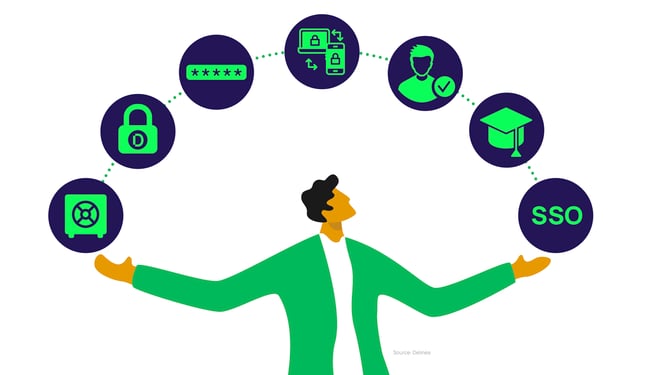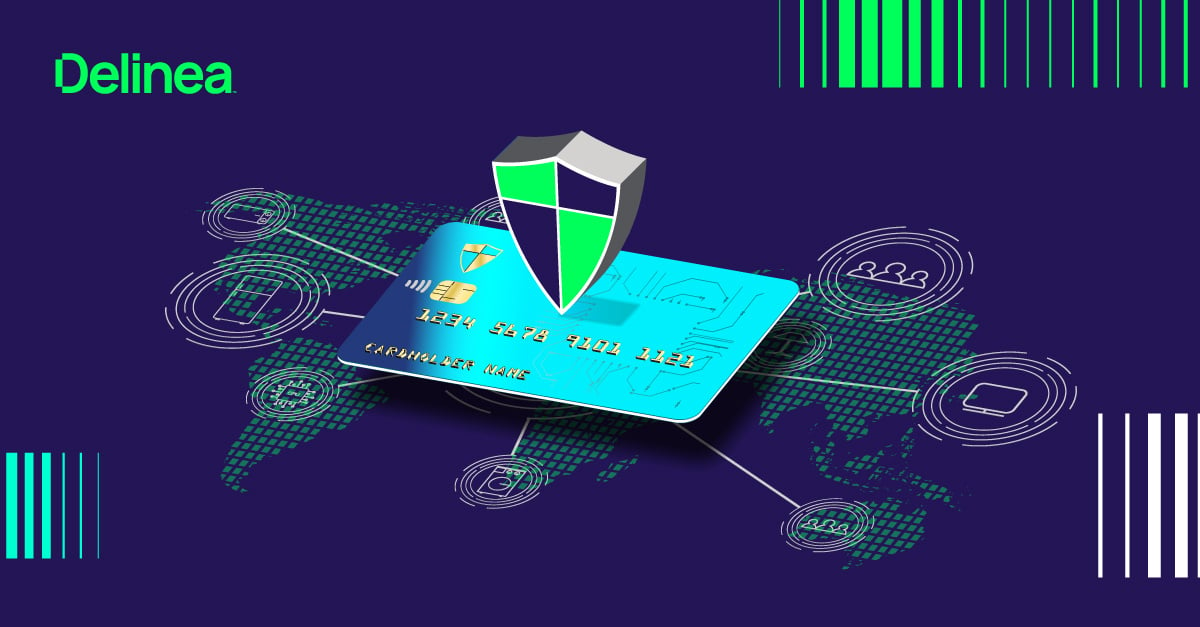20 password management best practices
Password management best practices are essential to protect your organization. When business credentials are compromised, attackers may access confidential information and gain control over IT systems, putting your entire organization at risk.
The proliferation of online accounts and services increases the risk of password-related breaches and compromises. Passwords are susceptible to phishing, credential stuffing, brute force, and dictionary attacks. Advanced hacking techniques and the rise of quantum computing pose unprecedented challenges to the security of password-protected systems.
In the enterprise, giving password management tasks to business users puts a lot of responsibility on their shoulders
Passwords are also inconvenient for users. Users often struggle with creating and remembering complex passwords, leading to poor password hygiene practices like reusing passwords, storing passwords in insecure places, and writing down passwords.
In the enterprise, giving password management tasks to business users puts a lot of responsibility on their shoulders. IT operations and security teams can remove this burden by centralizing and automating many password management best practices.

Below are 20 password management best practices you can implement to protect your users and your organization:
1. Centralize password management
By centralizing password management as a responsibility of the IT team, you can implement consistent password policies and have oversight to ensure those policies are followed. Centralized password management ensures that passwords meet security requirements and enable auditability into password hygiene across the business.
2. Store passwords in a secure vault
Users who rely on spreadsheets or sticky notes to store passwords can easily be compromised. Instead of relying on users to decide how they will store passwords, provide a solution that is easy for them to access. As part of your centralized password management program, your first step should be to establish an encrypted password vault where all passwords should be stored.
For personal password management or small businesses, leveraging a reputable password manager is a cornerstone of password management best practices. These tools generate and store complex, unique passwords for each of your accounts, significantly reducing the risk of unauthorized access.
For larger businesses and enterprises, Privileged Access Management (PAM) not only enforces and stores strong passwords but also enables strong access controls so that credentials provide only the access users need, when they need it.
3. Avoid storing passwords in browsers
Browsers aren’t intended for password management; unfortunately, most have security disabled by default. Browser-based password storage lacks security and productivity features compared to dedicated solutions. Storing passwords in a browser is risky because passwords can be easily retrieved if a device is stolen or if the browser is compromised through cyberattacks, malware, or malicious extensions.
If your organization permits users to use the browser for storing passwords, enforce a secure-by-design approach and enable the browser password security features. Better yet, enterprise password managers and PAM solutions have browser extensions that manage credentials for websites and web applications. Then, users can save, manage, and autofill credentials without bypassing the central, secure password vault. Integration between browsers and PAM solutions helps move passwords into the background reducing the need for users to choose passwords, which also reduces password reuse.
4. Add extra security for your master password
The administrator of your enterprise password vault has tremendous responsibility. Ensure that the password they use for vault administration is kept in an extremely secure place and managed with additional layers of authentication. For personal password managers, small businesses password managers, and PAM solutions, ensure that at least Multi-Factor Authentication is enabled for your master password to make it difficult for attackers to compromise. You may also want to implement geofencing and additional layers of approval.
5. Prepare for disaster recovery
To ensure cyber resilience in emergency scenarios, you’ll want to implement best practices like database mirroring, geo-replication, and break glass access. That way, users will still be able to access passwords for business continuity. Choose a strong password manager or PAM solution that offers high availability to ensure your business always has the access you need.
6. Restrict access to passwords
Only people who are approved should have access to passwords. Those people could be employees, contractors, vendors, or partners. Passwords should never be shared with people who aren’t authorized to use them. Enterprise password managers and PAM solutions can enable remote access to applications and systems without disclosing the passwords. Once the task is completed, the password can be rotated, reducing password disclosure time to the minimum and reducing risk.
7. Define and enforce policies that require strong passwords
Follow best practices for password or passphrase length and complexity, so they are more difficult for people or password-cracking tools to guess. Password length is more important than complexity, and together these factors make a password stronger.
8. Prevent password reuse
Each password used in your organization should be unique. Never associate the same password with multiple people or provide access to multiple systems.
9. Manage passwords throughout their lifecycle
Periodically review stored passwords and remove any you no longer use or need. Force password changes upon a schedule or even on an ad-hoc basis.
10. Make sure passwords are easily accessible to users
Many of these password management best practices require changing user behavior. People who are used to doing their own thing will be unwilling to change if you make the process too difficult. Make sure your password vault is easy to use and that users can access it wherever they work, using laptops or mobile devices.
11. Implement Single-Sign-On
Single-Sign-On (SSO) reduces the password management burden for users because they can authenticate once and use SSO to access multiple applications. While SSO makes it much easier to manage access to multiple applications and simplify the user experience, it’s critical to add additional security requirements for SSO, such as Multi-Factor Authentication (MFA) and Privileged Access Management, so that if a credential or password is compromised an attacker’s access is limited. SSO should always be combined with PAM to ensure both authentication and authorization are secure.
12. Integrate your password vault with other business solutions
To make password management easier for your IT and security teams, your password manager or PAM solution should be integrated within your enterprise IT ecosystem and work seamlessly with any other tools that manage user identities and system access.
The best practice here is to integrate your vault with Active Directory or Azure AD (Now Entra ID) to tie users to unique identities. You may also want to integrate with workflow tools for routing help desk requests for things like password resets, and IGA systems like Service Now or FastPath for identity governance.
13. Monitor password use
Track when and how often passwords are used and who they are used by. This will help you set a baseline for password activity that will allow you to identify any anomalies.
14. Identify unexpected password use and password abuse
Once you have that baseline, you can see when password behavior varies. For example, users may log in during unexpected hours or from unusual devices. Then you can add additional security checks and, if needed, investigate to see if the user’s password activity was potentially malicious. If the risk is high, you could use Multi-Factor Authentication or reviews to determine whether the password is authorized and approved.
15. Incorporate password management in your incident response plan
Let’s say a ransomware attack happens, or you detect a cyber breach. You’ll want to be able to force password resets for everyone in the organization. That way, you can lock out an intruder from doing more damage. Check out the Incident Response Plan Template for more recommendations.
16. Demonstrate compliance with password management best practices
Ensure your password management practices comply with your industry’s regulations and data protection laws such as NIST, PCI, HIPPA etc. You’ll want to be able to pull reports and share them with auditors to demonstrate your password management practices, including any incident response actions you’ve taken. You'll also want to be prepared with a structured incident response in the event you experience a breach. Take a look at our blog: Incident response lifecycle for identity-related attacks.
17. Educate employees on password management best practices
As part of your cybersecurity awareness program, make users understand why you’ve implemented these password management best practices to protect your organization. You may also want to reinforce how they can protect their personal passwords with similar best practices. Provide your employees with resources such as Cybersecurity for Dummies to increase cybersecurity awareness:
18. Validate identities with Multi-Factor Authentication
Even if you follow all these password management best practices, cybercriminals are always getting more sophisticated, and passwords can be stolen. Identity assurance strategies like Multi-Factor Authentication add an extra layer of security by requiring a second form of verification, such as a one-time code sent to a mobile device. That way, you can make sure the password user is who they say they are.
19. Put passwords behind the scenes
An advanced best practice for password management is to put passwords entirely behind the scenes. They can be created, rotated, and monitored automatically, and a user never even sees or creates them. That way, there is no risk of a user inadvertently memorizing and sharing a password or someone looking over their shoulder to steal it.
20. Implement an enterprise password management solution
For personal or small businesses, a strong password manager is sufficient to manage and secure your personal passwords and should include several of the password management best practices found here in this blog.
For larger businesses and enterprises, PAM incorporates all these password management best practices and more. PAM gives you peace of mind that passwords are managed securely and takes the burden off your users so they can focus on their jobs without worrying about password management.
Learn more about password management best practices
Free password tools:
Active Directory weak password finder
Browser-stored password discovery tool
Recommended reading:
Whitepaper: Beyond Password Managers
Blog: 5 most popular password cracking tools cyber criminals use to crack your enterprise passwords
Webinar:
Watch our on-demand webinar on a passwordless future
Podcast: The State of Passwords
Check out our podcast:


